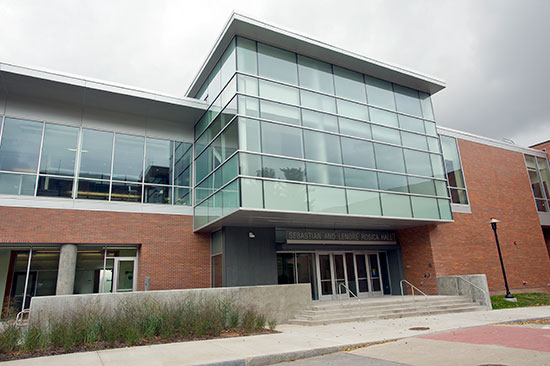NTID’s Rosica Hall officially opens
Mark Benjamin RIT/NTID
Officials from NTID and representatives of the Rosica family cut the ribbon to Sebastian and Lenore Rosica Hall on Oct. 11.
After more than three years of planning and construction, Sebastian and Lenore Rosica Hall opened Friday with a ribbon cutting witnessed by several hundred students, faculty, staff, alumni and guests at RIT’s National Technical Institute for the Deaf.
“This affirms RIT as a world leader in postsecondary education and enterprise development for deaf and hard-of-hearing students,” said Diana Spencer, executive director of the William G. McGowan Charitable Fund, which donated $1.75 million to help construct the building. “It will foster important research and nurture creative entrepreneurs in the deaf and hard-of-hearing community. It will be a springboard to the global community that will benefit all involved.”
Adjoining the Dining Commons, the $8 million, two-story, 23,000-square foot building is devoted to innovation and research for students, faculty and staff of the National Technical Institute for the Deaf and RIT.
“Rosica Hall is an amazing facility, not only for its beauty, but for what it represents for RIT/NTID students,” said NTID Student Congress President Ashleen Evans. “From the centers to the classroom space to the artwork, everything is designed to help us think in new and different ways.”
The design of the building was done with the intention to make it deaf-friendly, incorporating a maximum use of natural light, open line-of-sight paths, safety features such as strobe lights, and minimizing vibrations from the building’s air conditioning and heating units. Philip Rubin, a former RIT/NTID student and architect in Palm Springs, gave recommendations prior to construction and attended the ribbon cutting.
“Rosica Hall is a place where imagination will fuel innovation by students, faculty and staff, and where the ‘right and left brain’ thinking will merge to help realize our shared vision of being of the nation’s leading institutions for student innovation,” said RIT President Bill Destler. “I was fortunate enough to tour Rosica Hall during a recent research festival, and came away more impressed and more inspired than ever.”
“The research projects that are happening within Rosica Hall are — in a word — inspiring,” said Ryne Raffaelle, RIT’s vice president for research and associate provost. “The building itself is a joy to be in. I have no doubt that students, faculty and staff, not only from NTID, but from RIT’s other colleges, will be clamoring to be part of the many research projects that will take place inside. The building’s design invites the kind of collaboration that sparks great thinking, and the nature of the research already being conducted inspires us all.”
NTID President Gerry Buckley thanked a number of generous donors who contributed to the construction of the building, including NTID alumni. And he noted several commissioned art works for the building and thanked the donors:
- “Coded Spectrum,” by Leo Villareal, a large panel of light-emitting diodes that change colors, donated by Sprint Relay with Jim and Pat DeCaro.
- “Imagination,” clear glass art by alumna and faculty member Jackie Schertz.
- “The Three Sisters,” representing the Iroquois Confederation’s nourishment of corn, squash and beans, by Gary Mayers.
- “Finding the Rosicas,” a large portrait of Sebastian and Lenore Rosica using more than 600 Rosica family photographs, by alumnus Leon Lim.
- “Metamorphasis,” by Scott Grove, donated by Jim and Pat DeCaro.
Some rooms in the building have intentionally not been filled yet to make room for future research projects. But research centers and labs already active in the building include:
- DeafTEC, formed in 2011 with a National Science Foundation Grant to create a National Center of Excellence as a resource for schools around the country that educate students in science, technology, engineering and math.
- The Research Center for Teaching and Learning, where diverse teams of faculty and students conduct research that will improve deaf education, expose students to research practice and prepare a future generation of RIT/NTID educational researchers and scholars.
- Research on Employment and Adapting to Change Center for Studies on Career Success, which studies employment and career success for deaf and hard-of-hearing people.
- And the Deaf Studies Laboratory, which studies the cognitive, language and psychosocial aspects of the deaf experience and provides structured mentoring experiences for future deaf scientists.
The second floor of the building houses the Imaginarium, where faculty and students will gather to develop creative and innovative ideas.
A meditation garden is on the first floor, with native plants that provides a common area where people can sit and think in peace.
Mark Rosica, chair of NTID’s Counseling and Academic Advising Services and a son of Sebastian and Lenore Rosica, said he is thrilled for the research and future discoveries that will happen in Rosica Hall. He noted the polio vaccine, GPS, laser surgery for cataracts and the Internet were all spawned from research at universities.
“Let’s see what we all can do with this wonderful facility,” he said.




